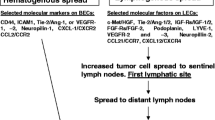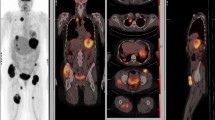Abstract
Metastasis to the regional lymph node is the most important prognostic indicator for the outcomes of patients with sold cancer. In general, it is well recognized that cancer development is genetically determined with progression from the microenvironment of the primary tumor site, oftentimes via the SLN gateway, to the distant sites. In about 20 % of the time, the cancer cells may spread directly through the blood vascular system to the distant sites. Thus, in general, cancer progression is consistent with Hellman’s spectrum theory in that development of nodal and systemic metastasis from a localized cancer growth is a progressive process. Cancer proliferation within the tumor microenvironment may give rise to increased tumor heterogeneity, which is further complicated by its continuous change through its evolution within the host in a Darwinian sense. It is crucial to understand the molecular process of lymphangiogenesis and hemangiogenesis in the tumor microenvironment with respect to the initial steps of cancer cells entering into the lymphatic and vascular systems so that rational therapy can be developed to curb the process of specific routes of metastasis. This chapter elucidates the role of lymphatics, nodal metastasis and antitumor immunity. We present novel immune targets in nodal metastases, the importance of the lymph node as a pre-metastatic niche, and immune-related proteins as biomarkers of metastasis.
Similar content being viewed by others
References
Morton DL, Thompson JF, Cochran AJ, Mozzillo N, Elashoff R, Essner R et al (2006) Sentinel-node biopsy or nodal observation in melanoma. N Engl J Med 355(13):1307–1317
Cox CE, Kiluk JV, Riker AI, Cox JM, Allred N, Ramos DC et al (2008) Significance of sentinel lymph node micrometastases in human breast cancer. J Am Coll Surg 206(2):261–268
Leong SP, Zuber M, Ferris RL, Kitagawa Y, Cabanas R, Levenback C et al (2011) Impact of nodal status and tumor burden in sentinel lymph nodes on the clinical outcomes of cancer patients. J Surg Oncol 103(6):518–530
Paget S (1889) The distribution of secondary growths in cancer of the breast. The Lancet 133(3421):571–573
Karnofsky HS (1994) Memorial lecture. Natural history of small breast cancers. J Clin Oncol 12(10):2229–2234
Hellman S (1997) Darwin’s clinical relevance. Cancer 79(12):2275–2281
Holopainen T, Bry M, Alitalo K, Saaristo A (2011) Perspectives on lymphangiogenesis and angiogenesis in cancer. J Surg Oncol 103(6):484–488
Tobler NE, Detmar M (2006) Tumor and lymph node lymphangiogenesis—impact on cancer metastasis. J Leukoc Biol 80(4):691–696
Rinderknecht M, Detmar M (2008) Tumor lymphangiogenesis and melanoma metastasis. J Cell Physiol 216(2):347–354
Pantel K, Brakenhoff RH (2004) Dissecting the metastatic cascade. Nat Rev Cancer 4(6):448–456
Witte MH, Dellinger MT, McDonald DM, Nathanson SD, Boccardo FM, Campisi CC et al (2011) Lymphangiogenesis and hemangiogenesis: potential targets for therapy. J Surg Oncol 103(6):489–500
Leong S (2006) Proceedings of the 1st international symposium on cancer metastasis and lymphovascular system: basis for rational therapy. Cancer Metastasis Rev 25:157–294
Leong S (2007) Cancer metastasis and the lymphovascular system: basis for rational therapy. Cancer Treatment and Research. New York: Springer
Leong SP (2009) Cancer metastasis: from local proliferation to distant sites. Humana Press, New York
Thompson JF, Soong SJ, Balch CM, Gershenwald JE, Ding S, Coit DG et al (2011) Prognostic significance of mitotic rate in localized primary cutaneous melanoma: an analysis of patients in the multi-institutional American Joint Committee on Cancer melanoma staging database. J Clin Oncol 29(16):2199–2205
Gershenwald JE, Soong SJ, Balch CM, American Joint Committee on Cancer Melanoma Staging C (2010) TNM staging system for cutaneous melanoma…and beyond. Ann Surg Oncol 17(6):1475–1477
Singletary SE, Greene FL, Sobin LH (2003) Classification of isolated tumor cells: clarification of the 6th edition of the American Joint Committee on Cancer Staging Manual. Cancer 98(12):2740–2741
Scheri RP, Essner R, Turner RR, Ye X, Morton DL (2007) Isolated tumor cells in the sentinel node affect long-term prognosis of patients with melanoma. Ann Surg Oncol 14(10):2861–2866
Baehner FL, Li R, Jenkins T, Hwang J, Kashani-Sabet M, Allen RE et al (2012) The impact of primary melanoma thickness and microscopic tumor burden in sentinel lymph nodes on melanoma patient survival. Ann Surg Oncol 19(3):1034–1042
Dillman RO, Aaron K, Heinemann FS, McClure SE (2009) Identification of 12 or more lymph nodes in resected colon cancer specimens as an indicator of quality performance. Cancer 115(9):1840–1848
Smith DD, Schwarz RR, Schwarz RE (2005) Impact of total lymph node count on staging and survival after gastrectomy for gastric cancer: data from a large US-population database. J Clin Oncol 23(28):7114–7124
Argiris A, Karamouzis MV, Raben D, Ferris RL (2008) Head and neck cancer. Lancet 371(9625):1695–1709
Duvvuri U, Simental AA Jr, D’Angelo G, Johnson JT, Ferris RL, Gooding W et al (2004) Elective neck dissection and survival in patients with squamous cell carcinoma of the oral cavity and oropharynx. Laryngoscope 114(12):2228–2234
Morton DL, Wen DR, Wong JH, Economou JS, Cagle LA, Storm FK et al (1992) Technical details of intraoperative lymphatic mapping for early stage melanoma. Arch Surg 127(4):392–399
Alex JC, Sasaki CT, Krag DN, Wenig B, Pyle PB (2000) Sentinel lymph node radiolocalization in head and neck squamous cell carcinoma. Laryngoscope 110(2 Pt 1):198–203
Chepeha DB, Taylor RJ, Chepeha JC, Teknos TN, Bradford CR, Sharma PK et al (2002) Functional assessment using constant’s shoulder scale after modified radical and selective neck dissection. Head Neck 24(5):432–436
Tassone F, Hagerman RJ, Taylor AK, Gane LW, Godfrey TE, Hagerman PJ (2000) Elevated levels of FMR1 mRNA in carrier males: a new mechanism of involvement in the fragile-X syndrome. Am J Hum Genet 66(1):6–15
Hughes SJ, Xi L, Gooding WE, Cole DJ, Mitas M, Metcalf J et al (2009) A quantitative reverse transcription-PCR assay for rapid, automated analysis of breast cancer sentinel lymph nodes. J Mol Diagn 11(6):576–582
Hughes SJ, Xi L, Raja S, Gooding W, Cole DJ, Gillanders WE et al (2006) A rapid, fully automated, molecular-based assay accurately analyzes sentinel lymph nodes for the presence of metastatic breast cancer. Ann Surg 243(3):389–398
Ferris RL, Xi L, Raja S, Hunt JL, Wang J, Gooding WE et al (2005) Molecular staging of cervical lymph nodes in squamous cell carcinoma of the head and neck. Cancer Res 65(6):2147–2156
Ferris RL, Xi L, Seethala RR, Chan J, Desai S, Hoch B et al (2011) Intraoperative qRT-PCR for detection of lymph node metastasis in head and neck cancer. Clin Cancer Res 17(7):1858–1866
Filho PA, Lopez-Albaitero A, Xi L, Gooding W, Godfrey T, Ferris RL (2009) Quantitative expression and immunogenicity of MAGE-3 and -6 in upper aerodigestive tract cancer. Int J Cancer 125(8):1912–1920
Andrade Filho PA, Ito D, Deleo AB, Ferris RL (2010) CD8+ T cell recognition of polymorphic wild-type sequence p53(65–73) peptides in squamous cell carcinoma of the head and neck. Cancer Immunol Immunother 59(10):1561–1568
Andrade Filho PA, Lopez-Albaitero A, Gooding W, Ferris RL (2010) Novel immunogenic HLA-A*0201-restricted epidermal growth factor receptor-specific T-cell epitope in head and neck cancer patients. J Immunother 33(1):83–91
Chapoval AI, Ni J, Lau JS, Wilcox RA, Flies DB, Liu D et al (2001) B7-H3: a costimulatory molecule for T cell activation and IFN-gamma production. Nat Immunol 2(3):269–274
Dong H, Strome SE, Salomao DR, Tamura H, Hirano F, Flies DB et al (2002) Tumor-associated B7-H1 promotes T-cell apoptosis: a potential mechanism of immune evasion. Nat Med 8(8):793–800
Flies DB, Chen L (2007) The new B7s: playing a pivotal role in tumor immunity. J Immunother 30(3):251–260
Zang X, Allison JP (2007) The B7 family and cancer therapy: costimulation and coinhibition. Clin Cancer Res 13(18 Pt 1):5271–5279
Greenwald RJ, Freeman GJ, Sharpe AH (2005) The B7 family revisited. Annu Rev Immunol 23:515–548
Freeman GJ, Gribben JG, Boussiotis VA, Ng JW, Restivo VA Jr, Lombard LA et al (1993) Cloning of B7-2: a CTLA-4 counter-receptor that costimulates human T cell proliferation. Science 262(5135):909–911
Cao Y, Zhang L, Ritprajak P, Tsushima F, Youngnak-Piboonratanakit P, Kamimura Y et al (2011) Immunoregulatory molecule B7-H1 (CD274) contributes to skin carcinogenesis. Cancer Res 71(14):4737–4741
Hodi FS, O’Day SJ, McDermott DF, Weber RW, Sosman JA, Haanen JB et al (2010) Improved survival with ipilimumab in patients with metastatic melanoma. N Engl J Med 363(8):711–723
Castriconi R, Dondero A, Augugliaro R, Cantoni C, Carnemolla B, Sementa AR et al (2004) Identification of 4Ig-B7-H3 as a neuroblastoma-associated molecule that exerts a protective role from an NK cell-mediated lysis. Proc Natl Acad Sci USA 101(34):12640–12645
Roth TJ, Sheinin Y, Lohse CM, Kuntz SM, Frigola X, Inman BA et al (2007) B7-H3 ligand expression by prostate cancer: a novel marker of prognosis and potential target for therapy. Cancer Res 67(16):7893–7900
Sun Y, Wang Y, Zhao J, Gu M, Giscombe R, Lefvert AK et al (2006) B7-H3 and B7-H4 expression in non-small-cell lung cancer. Lung Cancer 53(2):143–151
Tekle C, Nygren MK, Chen YW, Dybsjord I, Nesland JM, Maelandsmo GM et al (2012) B7 = H3 contributes to the metastatic capacity of melanoma cells by modulation of known metastasis-associated genes. Int J Cancer 130(10):2282–2290
Arigami T, Narita N, Mizuno R, Nguyen L, Ye X, Chung A et al (2010) B7-h3 ligand expression by primary breast cancer and associated with regional nodal metastasis. Ann Surg 252(6):1044–1051
Hanahan D, Weinberg RA (2000) The hallmarks of cancer. Cell 100(1):57–70
Hanahan D, Weinberg RA (2011) Hallmarks of cancer: the next generation. Cell 144(5):646–674
Tang D, Kang R, Livesey KM, Kroemer G, Billiar TR, Van Houten B et al (2011) High-mobility group box 1 is essential for mitochondrial quality control. Cell Metab 13(6):701–711
Rhim AD, Mirek ET, Aiello NM, Maitra A, Bailey JM, McAllister F et al (2012) EMT and dissemination precede pancreatic tumor formation. Cell 148(1–2):349–361
Weiner LM, Lotze MT (2012) Tumor-cell death, autophagy, and immunity. N Engl J Med 366(12):1156–1158
Fox BA, Schendel DJ, Butterfield LH, Aamdal S, Allison JP, Ascierto PA et al (2011) Defining the critical hurdles in cancer immunotherapy. J Transl Med 9(1):214
Peinado H, Lavotshkin S, Lyden D (2011) The secreted factors responsible for pre-metastatic niche formation: old sayings and new thoughts. Semin Cancer Biol 21(2):139–146
Tang D, Kang R, Livesey KM, Zeh HJ 3rd, Lotze MT (2011) High mobility group box 1 (HMGB1) activates an autophagic response to oxidative stress. Antioxid Redox Signal 15(8):2185–2195
Livesey K, Kang R, Vernon P, Buchser W, Loughran P, Watkins SC et al (2012) p53/HMGB1 complexes regulate autophagy and apoptosis. Cancer Res 72:1996–2005
Hoppo T, Komori J, Manohar R, Stolz DB, Lagasse E (2011) Rescue of lethal hepatic failure by hepatized lymph nodes in mice. Gastroenterology 140(2):656–666 e2
Galon J, Costes A, Sanchez-Cabo F, Kirilovsky A, Mlecnik B, Lagorce-Pages C et al (2006) Type, density, and location of immune cells within human colorectal tumors predict clinical outcome. Science 313(5795):1960–1964
Vakkila J, Jaffe R, Michelow M, Lotze MT (2006) Pediatric cancers are infiltrated predominantly by macrophages and contain a paucity of dendritic cells: a major nosologic difference with adult tumors. Clin Cancer Res 12(7 Pt 1):2049–2054
Zhang Q, Raoof M, Chen Y, Sumi Y, Sursal T, Junger W et al (2010) Circulating mitochondrial DAMPs cause inflammatory responses to injury. Nature 464(7285):104–107
Tang D, Lotze MT, Kang R, Zeh HJ (2011) Apoptosis promotes early tumorigenesis. Oncogene 30(16):1851–1854
Author information
Authors and Affiliations
Corresponding author
Rights and permissions
About this article
Cite this article
Ferris, R.L., Lotze, M.T., Leong, S.P.L. et al. Lymphatics, lymph nodes and the immune system: barriers and gateways for cancer spread. Clin Exp Metastasis 29, 729–736 (2012). https://doi.org/10.1007/s10585-012-9520-2
Received:
Accepted:
Published:
Issue Date:
DOI: https://doi.org/10.1007/s10585-012-9520-2




